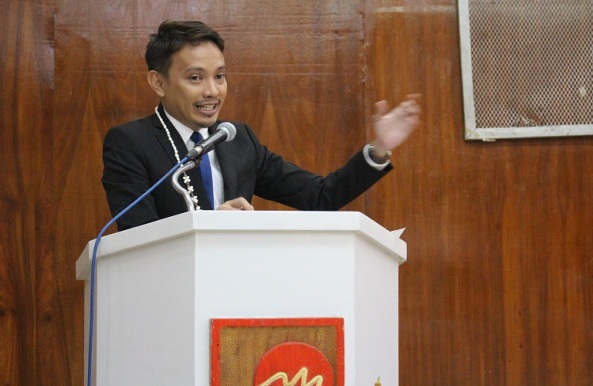By Roi Lomotan

DUMAGUETE CITY (PIA) – Broadcast journalist and 2015 Marshall McLuhan awardee Joseph Morong encourages young people to see the issue of the Mindanao peace process in a wider perspective.
Morong, who is a senior reporter of GMA-7, was in Silliman University recently to give a talk on “Communicating the Message of the Bangsamoro” as part of the Marshall McLuhan Forum Series on Responsible Media which was sponsored by the Canadian Embassy.
Students from Silliman University and Negros Oriental State University, most of them enrolled in mass communication, attended the forum.
In his talk, Morong told students to view the issue of the peace process and the Bangsamoro not only through the lens of the Mamasapano debacle but also through its historical context and other related issues.
He pointed out that there is a tendency to get emotional and become biased on the issue if they will only see it from the aspect of the Mamasapano tragedy without having prior knowledge on the peace process and the Bangsamoro Basic Law (BBL).
He showed his audience the result of a survey conducted by the Social Weather Station (SWS) in June 2015 which reveal that 44% of the respondents have little knowledge on the BBL while 37% say they have no knowledge on the BBL, 16% have partial but sufficient knowledge on the topic, and only 3% have extensive knowledge on the issue.
The problem goes back to the colonial period when the Treaty of Paris was signed and the Philippines was turned over by Spain to America.
Prior to this, early Muslims in Mindanao had already established a political and military system in island which became the reason why Spanish colonizers failed to conquer the island, therefore, therefore Mindanao at that time was not subjugated to Spanish political existence and was not added to the Spanish colonies in the country.
However, with the signing of the Treaty in 1898, Mindanao became part of the Philippine territory that was sold by the Spaniards to the Americans.
From then on, people from Luzon started going to Mindanao and grabbed lands owned by the native settlers in the island.
The broadcast journalist acknowledged that there was a lack of focus in the media in presenting the historical context of the Bangsamoro in the news and there was overemphasis given on the Mamasapano tragedy.
This was also reflected in the study conducted by the Center for Media Freedom and Responsibility (CMFR) on the Coverage of the BBL, which he also presented in the forum.
Morong read the findings of the study which say “there was a scant reference in the news to the serial measures of injustice suffered by these communities as the national government declared much of their land as frontier country open to homesteaders and plantation owners moved in from outside Mindanao.”
“The coverage of the Mamasapano caused a dramatic turn-around in public attitude which moved from acceptance of the signing of the CAB (Comprehensive Agreement on the Bangsamoro) to anger and hostility,” he added.
He cited that one reason for this might be that some reporters find it difficult to understand the complex issue of the Bagsamoro peace process.
Aside from this, stories on peace process is not seen “sexy” or attractive because it concerns mostly about policies, he said.
Morong, who has been covering the Bangsamoro peace process for many years, disclosed that his interest on the topic remains because of the stories of struggles of the people living in the affected areas.
“You hear the same stories, the names have changed but (its) the same narrative: cycle of poverty, cycle of war. I told myself, there’s something wrong,” he noted.
Morong believes the way to solve Mindanao’s problems is to set aside prejudices on Muslims.
He emphasized to his audience that they should always remember that they are the same with the young people in the Bangsamoro states – they have dreams and they are also Filipinos.
Meanwhile, Morong also advised future journalists that they can bring a deeper dimension on war reporting when they also tell stories happening in the fringes.
“The goal there is to get as many voices in the debate as possible. Your job as a journalist is to include as many voices as you can and pay even more attention to the voices that not heard. These are the minority,” he added. (rmn/ral/PIA7-Negros Oriental/This article was first published at PIA website on Mar. 14, 2016)

